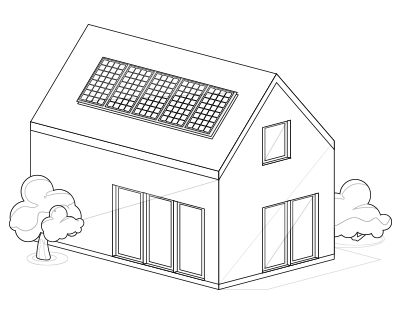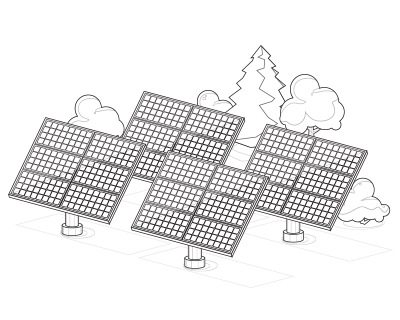Everything You Need to Know
Solar Panel Installation
Our energy experts will make sure you understand every step of the installation process. We’ll break down everything you need to know about solar panel installation so you have a crystal-clear view of how solar panel installation works before you commit.
Our Process
We're here to help you take control of your energy usage and reduce your carbon footprint.
We want you to feel confident in your energy choices and trust that your provider has your best interests at heart.
Evaluation
Our evaluation process is all about you. We’ll work with you to understand any questions you may have, provide answers, and make sure you feel comfortable about solar panel installation before going ahead with solar panel design.
Design
We design our solar systems to meet your unique energy needs and eliminate the huge variable expenditure that comes with relying on the traditional utility model, ensuring maximum energy efficiency and cost savings.
Site Survey
We will also conduct a site survey to make sure installation can be completed successfully and within the allotted time frame. Our survey will also examine your roof and electrical system to evaluate its solar readiness and ensure our designs are compatible with your home.
Permitting
Once we have verified that your home is ready, we’ll go ahead and start taking care of all the details for installation, including any utility, city or county permits that may be required before installation.
Installation
We’ll work quickly and efficiently to install your solar panel system, ensuring minimal disruption to your daily routine. The installation itself is typically completed within 1-2 days.
Inspection
As part of the installation process, we will also coordinate and undertake any utility, city or county inspections needed after installing your new solar panels.
Permission to Operate (PTO)
Once the solar panels are installed, we’ll make sure you have the green light to start powering your home.
Your Installation Options
When it comes to solar panel installation options, there are a few options available depending on the size of your home, its structure, current electrical system, and layout.

Roof Mounted
Roof mounted solar panels can be a suitable option for a number of homes but especially in urban areas with limited space. Roof mounted solar panels can be installed to take up any unused roof space and optimally positioned to capture as much sunlight as possible.

Ground Mounted
Ground mounted solar panels are an option if there is not enough roof space or the roof is not a suitable angle for solar panels. Ground mounted solar panels are also a good choice for areas with unpredictable weather (such as hurricanes or heavy snowfall) as they can be secured more firmly to the ground and adjusted for sun exposure as needed.
How to Ensure Roof Readiness to Install Solar Panels
If you opt for a roof mounted solar panel, there are a few considerations to consider to ensure that your roof is ready for solar panel installations.
01
Suitable Roof Slope
Determining the slope or pitch of the roof is vital to consider for panel placement and installation. Some of the factors that we evaluate include the latitude and climate of the location, the type of solar panel being installed, and the energy output needed for the home. The roof slope must also be in the right range for sunlight exposure.
02
Square Footage
The square footage of the roof will be important in determining how many panels can be installed based on the energy output needed for the home. The more square footage you have available means more solar panels can be installed.
03
Roofing Materials
Roofing materials are essential to consider as they will provide the foundation and support for the panels. The materials used in the roof must be able to withstand the weight of the panels, as well as weather and environmental factors.
Roofing materials such as shingles, metal roofing, and tile are common roofing materials, and all have their unique considerations in determining the right solar panels. We need to evaluate your roofing materials to ensure that the solar panels being installed are the right weight and size, and to consider any additional security measures necessary to fasten the solar panels onto the roof.
04
Roof Age and Condition
Roof age and condition are important to take into account when installing solar panels. As the installation process requires drilling holes, attaching, and mounting hardware, the roof must be structurally sound and in good condition to prevent any major damage to the roof or the panels.
The roof needs a lifespan of at least 10-15 years for solar panel installation and functioning, but its condition is equally important to look at before installation.
Is Ground Mounting Right For You?
Ground mounting may be the right choice for you if your roof is not in the best age or condition for installation. Ground mounting may be a more cost-effective option depending on your roofing materials or if there are concerns with the age and condition of the roof.
Additionally, ground mounting may also be a good option if you live in an area with extreme weather, as ground mounting offers a more secure installation and mounting process that can withstand the elements. If you are unsure of whether ground mounting or roof mounting is right for you, our team can provide you with personalized recommendations so that you can make the most informed decision!
Steps to Powering Your Utilities With Solar Energy
Once your solar panels are installed, you can move forward with tapping into solar energy to power your home. This requires undertaking the interconnection process, where you can apply for and receive permission from your local utility company to connect to the utility grid. You will also need to look at net metering and any regulations or policies set up by your utility company regarding solar production buyback.
Our Process
Each homeowner system is sized differently based on state and local utility requirements, so the process will vary based on individual circumstances.
The process typically entails the following steps:
01
We’ll Coordinate With Your Electricity Provider
We contact the energy provider on the homeowner’s behalf to get started powering your utilities with solar energy and will coordinate on the details needed to connect your home.
02
AMP Requirements
We will work with your energy provider to understand AMP requirements to successfully connect your home to the energy grid.
03
Get Permission to Install
Once we have identified the AMP requirements, we will work with the energy provider to obtain permission for solar panel installation.
04
Schedule an Inspection
Once the installation permission is granted, we will coordinate with the energy provider to schedule an inspection and ensure installation is undertaken safely, securely, and within the parameters of local utility requirements.
Project Support & Customer Service
Throughout the installation process, you will have a dedicated project manager who will coordinate details and keep you informed throughout the entire process. Following installation, you will also have access to an app with all the details of your solar panel, installation, and other information in one place.
